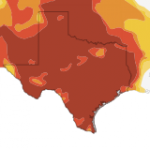What to Expect at the TAMEST Water Summit Today

Photo courtesy of the University of Texas at Austin
Dr. Danny Reible will chair the 2012 Texas Water Summit.
Water, water everywhere. Let’s keep some drops to drink. But how? That’s why scientists, politicians, and water utility leaders are meeting up today for the 2012 Texas Water Summit from the University of Texas at Austin’s Academy of Medicine, Engineering and Science. It will feature prominent statewide leaders on water issues like state climatologist John Nielsen-Gammon, San Antonio Water System’s CEO Robert Puente and Robert Mace of the Texas Water Development Board.
To get a preview of the summit, StateImpact Texas’ Terrence Henry talked to its director, Danny Reible. He works at the University of Texas’s Center for Research in Water Resources. He is also the program chair for the summit. The interview was edited for clarity and content.
Q: Tell us about what people can expect from this conference.
A: The Texas Water Summit is an effort to explore the consequence of our drought. What is our availability of water? What are our needs for water? And ultimately how can we match the gap between the two now and in the future?
Q: What are some of the issues you’ll be looking at?
A: Some of the big questions are the uncertainty in the availability in water. As we move forward, as a result of potential climate change, what might that do to the frequency of drought, for example? And then, to what extent, as we look at the growth and the population of the state, can we conserve water and reuse water in municipalities? That’s certainly a significant fraction of our water use today but as we are nearly doubling in population, or expected to nearly double in population in the next fifty years, what can we really expect out of conservation and reuse and the pressure on water demand by municipalities? I suspect that, in fact, our municipalities or cities are going to have an increase in water usage even if we do an awful lot of reuse and conservation. Just the population growth will mean that, at best, we’ll probably stay even. And so that when we’re faced with drought, we’re going to have problems. And how do we match up that water that we have? Where do we conserve in other areas? Are there sources of water, new sources that we can tap into? So these are the issues that we are going to be addressing in this one-day conference.
Q: We’ve been getting a lot of questions about whether or not the drought is over, along the lines of ‘Did we make it through this drought? If so, do we really need to worry about more in the future?’
A: That’s actually the worry that I have, is that if we have made it through the drought, and it’s certainly a promising year so far, that people will become less concerned. And that is the traditional view that we’ve had for planning for water in Texas. That is, we pray that it will rain. Well, I would say that last year we recognized that that is not a plan. And that we need to be a little more proactive – we need to be a lot more proactive – in how we manage water and see it into the future. And so we don’t know whether the drought is over, and I would hope that even if it is over, that we don’t forget that we need to be much more proactive in our planning for water into the future.
Q: Are there important issues that are being left out of the discussion about water usage in Texas?
A: I believe that we probably are not talking as much as we should about some of the largest users of water and how we can help those users conserve that water. And the two largest users are agricultural irrigation and cities. So even though there is a lot of discussion about how we can improve efficiencies in both, because of their prominence and overall use of water – we’re talking approximately 85 percent of our total water demand are those two alone. I don’t think we spend enough time discussing how we can conserve better in those two areas.
Q: It also seems like an area ripe for conflict – growing cities versus farming and ranching.
A: I think there is a potential for conflict, and I believe that ultimately what this will do is put an upward demand or upward pressure on the cost of water, which will encourage conservation on both sides. But as the cost for water goes up, that provides opportunities for those that have water rights that are dependent on relatively cheap water, they might find it more useful to actually sell that water to municipalities, for example. There will be conflict. There will be certainly difficulties in redistributing water and meeting the efficiencies and everyone getting what they would like out of our water supply. But I think there are opportunities, and through things such as our forum, we’re trying hard to pull all the stakeholders together so that we can try to identify what our common needs and challenges might be.
Daniel Ramirez is an intern with StateImpact Texas.

